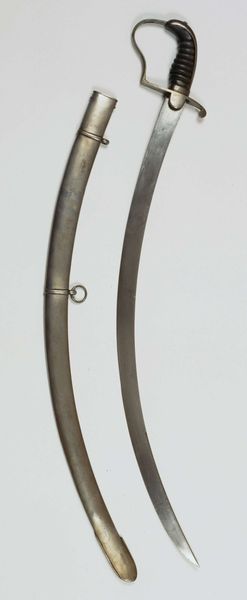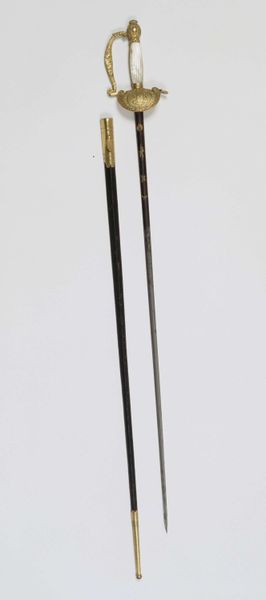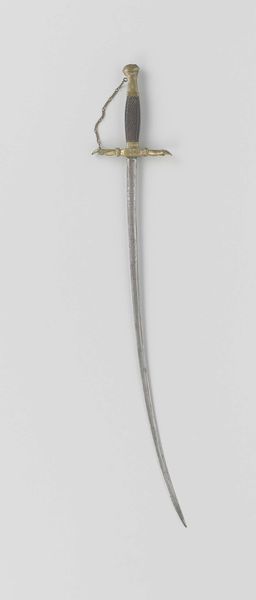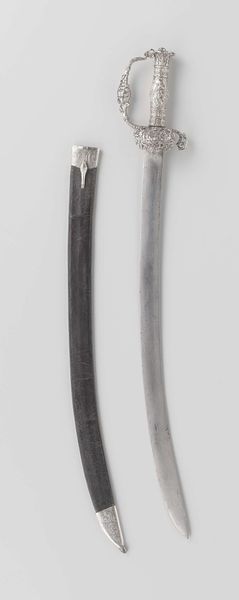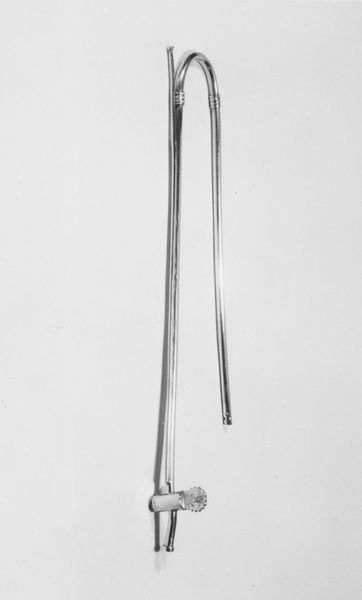
Sabel met schede officieren lichte cavalerie model nr. 1, afkomstig van J.A. de Vos van Steenwijk c. 1798 - 1852
0:00
0:00
print, metal, engraving
#
medieval
# print
#
metal
#
form
#
line
#
islamic-art
#
engraving
Dimensions: length 94.5 cm, width 16 cm, height 2.5 cm, length 82.7 cm, width 34.5 mm, thickness 8.7 mm
Copyright: Rijks Museum: Open Domain
Curator: Here we have a saber with scabbard, specifically for light cavalry officers, model number 1. It was originally owned by J.A. de Vos van Steenwijk and dates from approximately 1798 to 1852. Editor: There's a somber austerity to it. The cold steel, the minimalist design… it speaks to a history of conflict and social power, but also restraint. It feels… efficient, devoid of unnecessary adornment. Curator: Absolutely. We need to remember that this wasn't merely a weapon; it was a symbol of status and authority within the military and broader social hierarchies. The materials – metal, engraving – speak to the wealth and industry required to produce such items. Editor: And what narratives were being reinforced? Whose stories are implicitly valorized, and whose experiences are sidelined in its glorification? Who exactly was J.A. de Vos van Steenwijk and what was his relation to any colonial atrocities? The aesthetic of power always begs those questions, I find. Curator: De Vos van Steenwijk was part of a powerful noble family and served in the military. His ownership of this saber situates him within a network of political and economic power. The style itself – the specific curve of the blade, the design of the hilt – reflects broader trends in military weaponry of that period. But I see your point – the individual's history and actions definitely frame the artwork and affect my interpretations of the materials, the style, everything. Editor: Context, in this case, really reveals its multifaceted and, ultimately, rather menacing implications. Looking at that sharp point, what did its form enable? Whose flesh was its function aimed to slice? But even detached from the historical reality, as it's presented here on display, this saber evokes a very specific presence in our contemporary gaze that forces reflection and critical thought on class, power, and the theater of war. Curator: I agree. Studying it now makes me want to learn more about the period when it was made, and how political turmoil may have impacted military officers during that era. Editor: Precisely, seeing such an instrument displayed like this invites reflection on how societal values get literally embodied into weapons of authority and tools of destruction.
Comments
No comments
Be the first to comment and join the conversation on the ultimate creative platform.
